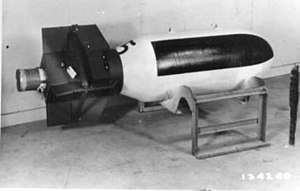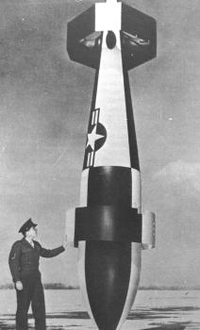Azon
AZON (or Azon), from "azimuth only", was one of the world's first guided weapons, deployed by the Allies and contemporary with the German Fritz X.
| AZON | |
|---|---|
 AZON, the first smart bomb developed by the United States. | |
| Type | Guided bomb |
| Place of origin | United States |
| Service history | |
| In service | 1944 |
| Used by | United States |
| Wars | World War II |
| Specifications | |
| Mass | VB-1: 1,000 pounds (450 kg) VB-2: 2,000 pounds (910 kg)[1] |
Operational range | 5,000 feet (1,500 m) |
Guidance system | MCLOS radio control system |
Officially designated VB-1 ("Vertical Bomb 1"), it was invented by Major Henry J. Rand and Thomas J. O'Donnell during the latter stages of World War II as the answer to the difficult problem of destroying the narrow wooden bridges that supported much of the Burma Railway.
AZON was essentially a 1,000 lb (454 kg) general-purpose AN-M65 bomb with a quadrilateral 4-fin style radio controlled tail fin design as part of a "tail package" to give the desired guidance capability, allowing adjustment of the vertical trajectory in the yaw axis, giving the Azon unit a lateral steering capability (meaning it could only steer left and right, and could not alter its pitch or rate of fall). This lack of any pitch control meant that the bombardier still had to accurately release it with a bombsight to ensure it could not fall short of or beyond the target. The "tail package" bolted onto the standard bomb warhead, in place of the usual sheet-metal fixed fins; this concept was an early iteration of a now common method of making modern guided bombs (such as the JDAM, the Paveway family, the KAB-500L, etc.): making the guidance and control units as separate pieces that attach to the tail and/or nose of a standard "iron bomb", making it into a guided weapon. There were gyroscopes mounted in the bomb's added tail package that made it an Azon unit, to autonomously stabilize it in the roll axis via operating a pair of ailerons,[1] and a radio control system to operate the proportional-control rudders, to directly control the bomb's direction of lateral aim, with the antennas for the tail-mounted receiver unit built into the diagonal support struts of the tail surface assembly.[1] The bomb's receiver and control system were powered by a battery which had around three minutes of battery life. The entire setup in the added "tail package" was sufficient to guide the weapon from a 5,000-foot (1,500 m) drop height to the target. Situated on the tail of the bomb was a 600,000-candela flare which also left behind a noticeable smoke trail, to enable the bombardier to observe and control it from the control aircraft. When used in combat, it was dropped from a modified Consolidated B-24 Liberator, with earlier development test drops of the Azon in the United States sometimes using the B-17 Flying Fortress as the platform.[1] Some ten crews, of the 458th Bombardment Group, based at RAF Horsham St Faith, were trained to drop the device for use in the European theater.
The ability to only control the path of the bomb in the azimuth direction, made AZON bombs most suitable for long and narrow targets, such as bridges or railways. A disadvantage of using an AZON bomb was that after a bomb was dropped the bomber could not break way immediately because the bombardier had to keep the bomb in view so he could guide it. The bombardier used a BC-1156 joystick control to adjust the course left or right. The directional commands were sent to the guidance package via a special-purpose radio system.[2]
The 493rd Bomb Squadron[3] also dropped Azon bombs in Burma in early 1945 from similarly-modified B-24s, based at Pandaveswar Airfield, India, with considerable success, fulfilling the designers' original purpose for the ordnance.
Azon operations
.jpg)
| Target | Date | Result |
|---|---|---|
| Melun | June 8, 1944 | Mission 400: an attack on the Melun bridge by an Azon unit is foiled by clouds. |
| Ham-sur-Somme | June 14, 1944 | Mission 412: 7 of 15 B-24s hit the bridge over the Somme at Ham and 5 use Azon bombs against targets of opportunity; no losses. |
| Étaples | June 15, 1944 | Mission 414: 12 B-24s use Azon bombs against Étaples railroad bridge and 7 others use the bombs against the Pecrone railroad bridge. |
| Saumur | June 22, 1944 | Mission 432: 9 of 10 B-24s use Azon bombs against the Saumur Bridge. |
| Esternay | August 17, 1944 | Mission 558: 10 B-24s are dispatched to drop Azon bombs on the Les Foulons rail bridge near Esternay but the mission is abandoned due to deteriorating weather. |
| Moerdijk | August 25, 1944 | Mission 571: 10 of 10 B-24s fly an Azon bomb mission to attack railroad bridge at Moerdijk, Netherlands but the target is missed by all 40 bombs launched. |
| Moerdijk | August 26, 1944 | Mission 577: a second attempt on the Moerdijk rail bridge is made with 9 aircraft, but clouds prevent an attack. |
| Ravenstein | September 1, 1944 | Mission 597: 12 of 12 Azon-equipped B-24s hit the Ravenstein rail bridge in the Netherlands, without loss. |
| Hemmingstedt & Kropp | September 13, 1944 | Mission 629: 6 of 11 B-24s dispatched on an Azon mission attacked the Hemmingstedt oil refinery and 5 hit the secondary target, ammunition dumps at Kropp. Operation Aphrodite guided bombs also attacked Hemmingstedt the next day. |

See also
- Bat (U.S. Navy autonomously radar-guided bomb)
- Fritz X
- GB-8
- Kehl-Strasbourg radio control link, for MCLOS control of WW II German PGM ordnance
- List of anti-ship missiles
References
- United States Office of Strategic Services (1943). WW2: Azon (1943) Radio-Controlled Dive Bomb (YouTube). The Digital Implosion. Retrieved 21 July 2013.
- Frantiska, Joseph, Jr. (2018-12-07). "The Azimuth "Smart" Bombs of World War II". Retrieved 2019-01-21.
- Marion. "Old China Hands, Tales & Stories – The Azon Bomb". oldchinahands. Archived from the original on March 6, 2012. Retrieved March 20, 2012.
- "8th Air Force 1944 Chronicles". Archived from the original on September 12, 2007. Retrieved 2007-05-25. June , July Archived 2008-03-03 at Archive.today, August, September
- "8th Air Force Historical Society". Archived from the original on 2010-10-18. Retrieved 2011-02-11.
- 458th Bombardment Group Website
External links
- NMUSAF page about the Azon ordnance
- Official 1943 USAAF film describing the AZON bomb
- USAAF and USN guided air-to-surface ordnance of World War II
- The Dawn of the Smart Bomb
- Guided weapons of World War II
- GB series weapons
- Account of AZON Bomb Use by the 458th Bomb Group in ETO
- Account of AZON Bomb Use by the 493rd Bomb Squadron in CBI Theater
- Video account of AZON Use Against the Burma Railway bridges
- WW II video of AZON Bomb Drop over Burma
- Another video of AZONs in action over Burma
